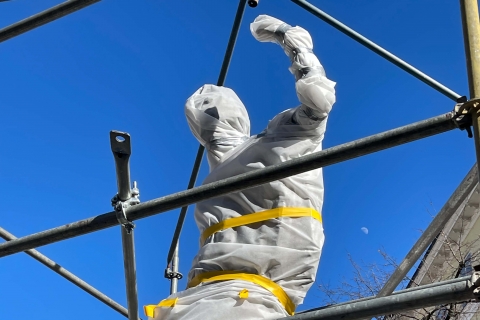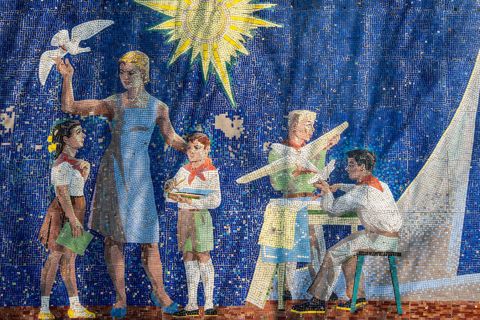Modest Monumentalism: Ukrainian Balcony Mosaics
The project’s author goes by the name of Taras and prefers to keep his last name to himself. An Odesa native, he is a cake baker by education and has experience working in television as a cameraman.
— I’ve spent most of my life in Tairova, a sleeper neighbourhood of Odesa. It was conceived as an experimental district in the end-1960s, so I was surrounded by those panel blocks of flats with unusual designs and well-planned quarters since childhood. Growing up in that environment, I naturally picked up photography and videography. I’ve never been interested in photographing people, but architecture is a different story. When I was out of sorts, I just took my camera and roamed the streets of my neighbourhood in search of new angles. I posted the pictures from those photo walks on an Instagram page we shared with a friend. We named it Tairova Melancholy and made it all about the district’s everyday life.
As I wandered around the older part of the neighbourhood one day, I noticed a square mosaic pane on a balcony. It got me thinking, why would the apartment building’s designers decorate it like that? So, I set out to walk around the entire district and find out how many variations of those mosaics were there. Whenever I told my friends about what I was doing, they were amazed at why they had never noticed those balcony mosaics. Then, I got the idea of cataloguing the mosaics and finding out more about them.
Odesa
Odesa
Yuzhne, Odesa Region
Yuzhne, Odesa Region
The abandoned Black Sea Resort in Odesa
The abandoned Black Sea Resort in Odesa
In 1955, Khrushchev denounced the ‘architectural excesses’, namely the ornate fretwork, monumental pillars, and the various sculptures that adorned the Stalinist-style buildings. That is where the turn toward Soviet modernism takes place, influenced by Industrialization and, to a much larger extent, by the state in which the post-war country was. A lot of cheap housing was required right then and there. Mosaics became the only loophole for the architects who wanted to decorate the faceless standard housing development. Besides, they were cheap and easy to mount on the flat surfaces of panel residential buildings.
From the looks of it, I’m the first to undertake such an investigation. I mean, it’s easy to find the author of a large mosaic mural you might see on an administrative building, school, or block of flats. Tracking down those who designed balcony mosaic panes was a whole different thing. I was trying to find at least some clue or person who could tell me about that thing. Nothing came up on the internet, and Odesa’s largest library wasn’t any help either. However, talking to the residents of the buildings decorated by those mosaics informed my own vision.
Balcony mosaics were created at house-building plants, meaning that it was up to the developer at the time to pick the pattern to decorate their building’s balconies with, hence the randomness of designs. You can find something unique to every city in Ukraine because the designs were made at the builders’ discretion. Balcony mosaics were made from ceramic tiles covered with colour glaze on the face side.
It’s easy to find the author of a large mosaic mural. Tracking down those who designed balcony mosaic panes was a whole different thing.
Kyiv
Kyiv
Kyiv
Kyiv
Irpin, Kyiv Region
Irpin, Kyiv Region
Balcony mosaics can be seen all over Ukraine. So far, I have found about 50 different patterns with almost a hundred colour variations. More often than not, the same designs could use dramatically different shades of colour depending on the paint a particular house-building plant had at its disposal. There is a curious connection between the placement of mosaic panes, their combinations, and the location of the buildings. Those facing central streets have neater mosaics with carefully selected colours and shapes. Meanwhile, backyard-facing mosaics can be absolutely chaotic. Cherkasy, Kherson, and Mykolaiv impressed me the most with their mosaic pane combinations.
Balcony mosaics lack any subject or symbolism — their function is purely decorative. It’s hard to tell if some patterns are more common than others. Still, there are universally used designs, that much is evident. One of them is Flower. I came up with pattern names myself, but anybody can notice something for themselves on closer inspection.
The buildings facing central streets have neater mosaics with carefully selected colours and shapes. Meanwhile, backyard-facing mosaics can be absolutely chaotic.
While working on this project, I made quite a few discoveries and found some legit art pieces that remained unnoticed for the most part. Sadly, some unique balcony mosaics have been lost. When I saw Kindergarten No. 49 in Odesa’s Cheremushky microdistrict, it was unbelievable. The building had over nine one-of-a-kind mosaic panes with all kinds of pictures. I had never seen anything of that kind anywhere in Ukraine. It sucks that all those mosaics were destroyed during the facility’s recent reconstruction.
Another discovery of mine was that balcony mosaic panes sometimes were used for purposes other than intended. In Zakharivka, Odesa Region, an entire dormitory building was covered in them instead of stucco. Another unique pattern is the one I call ‘Broken Pixel’. It is unique in that it was made from leftover tiles, and there are literally no two of those alike. Also, balcony mosaic panes were used to decorate private garages and even bus stops.
Sakharivka, Odesa Region
Sakharivka, Odesa Region
A kindergarten in Odesa
A kindergarten in Odesa
A garage decorated with mosaics, Odesa
A garage decorated with mosaics, Odesa
A bus stop in Torosove, Odesa Region
A bus stop in Torosove, Odesa Region
Soviet heritage is seemingly everywhere nowadays, whether we like it or not. Ukraine is full of buildings and works of that period protected as architectural assets. Also, keep in mind that those were almost always designed by Ukrainian architects. Unfortunately, monumental art preservation gets very little funding. Besides, many unique mosaics and stained glass windows have been destroyed by enemy shells since Russia launched its invasion of Ukraine. I believe these things are worth being preserved, lest we lose an entire layer of cultural heritage in the coming years.
Before Russia invaded, I was going to take a trip around Ukraine to document as many balcony mosaics as I could and then publish the entire catalogue of what I had found as an art book. Also, I wanted to shoot a documentary about those mosaics as a phenomenon. Now, however, both projects have been put on the back burner. I hope to finish the Soviet Pixel project once Ukraine wins this war, especially as there is more than enough material left.
I believe these things are worth being preserved, lest we lose an entire layer of cultural heritage in the coming years.
Chornomorsk, Odesa Region
Chornomorsk, Odesa Region
Mykolaiv
Broken Pixel pattern in Mykolaiv
Broken Pixel pattern in Mykolaiv
Mykolaiv
Flower pattern in Odesa
Flower pattern in Odesa
Cherkasy
Cherkasy
Bilhorod-Dnistrovskyi, Odesa Region
Bilhorod-Dnistrovskyi, Odesa Region
New and best






